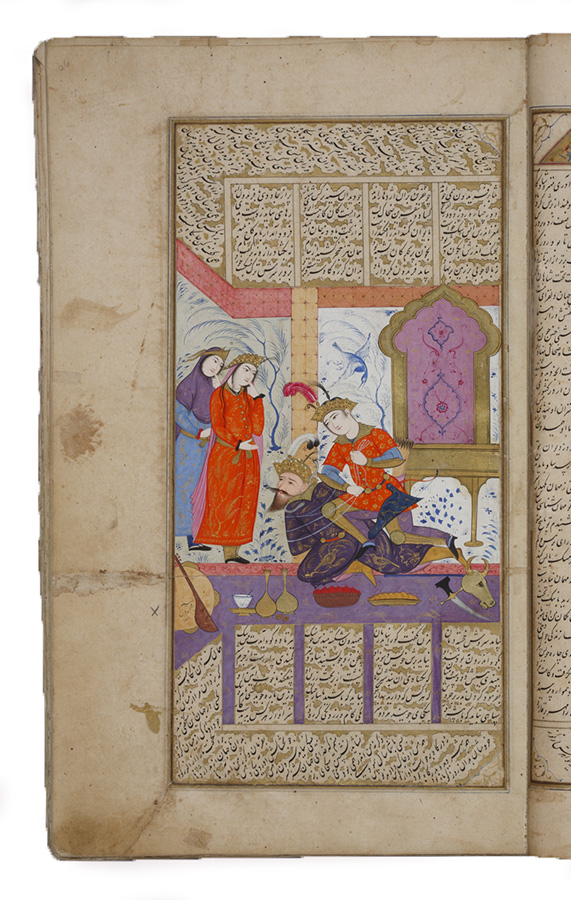Manuscript B, no. 1-168 (David folio 13a)
Faridun Binds Żaḥḥāk in the Presence of Šahrenāz and Arnavāz
Location: The David Collection, Copenhagen, Denmark, #217/2006, folio 13a.
Page: 35.2 x 21.8 cm.
Painting: 13.7 x 14.0 cm. (Scaled) without extension top left into the margin
Text area: 28.7 x 14.0 cm. (Scaled)
Signature in the lower left corner of the painting: raqam-e kamina moʿin-e moṣavver.
This scene depicts Faridun's victory over the evil king Żaḥḥāk while the two sisters of Jamšid, the previous shah, observe from the side. Żaḥḥāk knew that the young Faridun would defeat him because he had dreamed that an Iranian prince with an ox-headed mace would overpower him. While the battle raged between Żaḥḥāk's army and the citizens of his realm, he slipped into his palace, intent on murdering the sisters of Jamshid. Instead he encountered Faridun, who bashed his head with his ox-headed mace. Then, in response to a heavenly message, Faridun refrained from killing the evil king and instead bound and took him to hang in a cave for eternity. In the illustration, Żaḥḥāk's empty throne awaits Faridun at the right while his mace lies in the foreground. The sisters of Jamshid, among the few women who appear in the illustrations to this manuscript, raise their forefingers to their lips in the gesture of astonishment.
The palette of this scene closely resembles that of the previous illustration (folio 8a), with its purple ground, violet throne, and bright red passages. Although the impassive facial expressions and the women's poses are standard fare in the work of Moʿin, he has added some subtle touches to this illustration, notably the minor variation of the background of the wall painting - white in the throne chamber and gray in the room to the left. This suggests that the sisters stand in a separate chamber, without interrupting the flow of the action taking place on a terrace in the foreground. The scale of the terrace is implied by the purple floor color, which fills the vertical strips between columns of text. Finally, the swooping bird in the mural above Faridun's head emphasizes the focal point of the composition.
A Shahnama of 1650 copied in Isfahan contains another version of this illustration.(fn.27) Rather than minimize the number of figures to focus on the key elements of the story, the Isfahan artist has added soldiers and courtiers as observers. These figures detract from the drama of Żaḥḥāk's capture and point up the care with which Moʿin populated his scenes in order to present the crux of the narrative. Why Moʿin and the Isfahan artist should have chosen to depict this episode, as opposed to the hanging of Żaḥḥāk at Mt. Demavand, is unclear.
Painting references:
Canby_ Journal_2010, pp.61-62 no.2 and p.84, fig.16.
Text references:
Warner, I, pp.167-68.
Photo: Permille Klemp. Courtesy of The David Collection, Copenhagen
Sheila R. Canby
Last Updated: January 5, 2014 | Originally published: 2010
